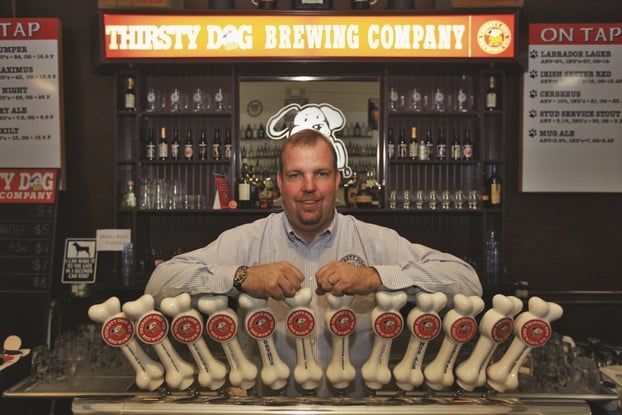
Craft beer tends to create a community culture. Craft brewers and drinkers alike love to come together to talk beer — new beers, old favorites, upcoming seasonals, the latest collaborations and even the brewing process. Building on that beer passion, brewers are fostering a customer community with tasting rooms that also improve the brewery’s bottom line.
“Based on our research, it’s critical to have a tasting room because you make more money selling beer on site as opposed to distribution,” explained Eddie Leon, owner of MIA Brewing Co. (which recently switched its name from Most Wanted Brewery due to a trademark dispute), a soon-to-open craft brewery in Miami that is currently in the design phase of building its facility, which includes a tasting room. “For example, instead of selling a keg for $80, you’re going to be retailing each pint, making maybe $400 off that keg. It’s a lot of profit. In Florida, there are a few breweries that put a lot of emphasis on their tasting rooms, and they make a lot of money from that.”
It’s not just Florida. Craft breweries across the country are putting an emphasis on their tasting rooms. Whether you’re an established craft brewer or just starting out, a tasting room should definitely be on your business plan radar as craft beer popularity rises and customers seek out more information about your beers.
“A tasting room is a huge asset,” said John Najeway, owner of Thirsty Dog Brewing Co., based in Akron, Ohio, which has run a successful tasting room for the past four years and continues to see growth. “You can look at dollars and say, ‘Yeah, it’s more than paid for itself and exceeded its expectations,’ but then there’s the immeasurable value, which is the face time and direct contact with the consumer.”
Growing and supporting your customer base? Massive profits? Sounds great! But there’s a business method to the tasting room madness. Craft brewers operating or building a tasting room need to have a clear vision and set goals for these craft beer brand-focused bars.
Tasting room form and function
Designing a tasting room isn’t as simple as building a bar into your brewery and pulling up a couple of bar stools. Tasting room factors that most appeal to customers include getting an inside look at the brewing operation, tasting limited-run beers and being in close proximity to the brewers — all of which should be in the forefront of your mind when building or reorganizing your tasting room.
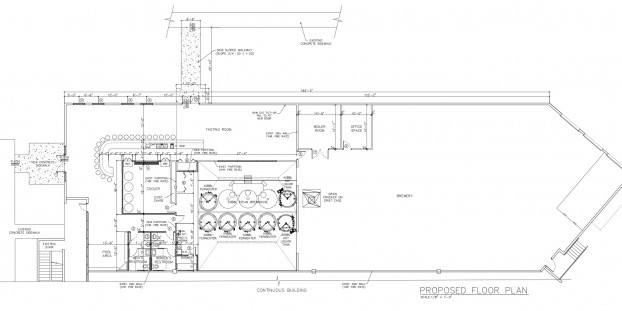
For Sierra Nevada Brewing Co., opening a tasting room meant thinking outside the box — and even outside the brewery. The California craft brewer is planning to open a tasting room in Berkley, Calif., which is about a two-and-a-half hour drive from the brewery located in Chico, Calif.
“By and large, unless folks have been to our brewery in Chico, they don’t see 19 beers of ours on tap. The opportunity to share the variety and breadth of beers we make in general was important to us,” explained Ryan Arnold, communications manager for Sierra Nevada. “Having had such a great support system in Northern California for the past 30 years, we wanted to stick to the general area. The craft beer scene, and the interest in craft beer, is certainly big in the Bay Area. That’s where we focused our search. Berkley was attractive because it’s arguably a central location within that Bay Area. It has an intriguing craft beer and food renaissance going on. That culture is really growing. It’s vibrant, and it’s a great place for us to try to become part of that fabric.”
Becoming part of the local community is a large part of tasting room success. For Thirsty Dog, building that crowd of locals has helped build its tasting room’s reputation. Najeway said he has regulars who call the brewery every week to find out what’s on tap. A group of tasting room regulars just happen to work at the local tire giant Goodyear, headquartered in Akron, Ohio, and from that simple brewer/drinker relationship grew a business partnership. Thirsty Dog has hosted six business events for Goodyear this year alone, everything from a sit-down salmon dinner on china with 20 auditors from around the world to Goodyear’s marketing department holding a meet and greet for 65 people at the tasting room.
Fancy dinners and business face time weren’t concepts that Najeway had planned on when he dreamed up his tasting room, but he kept an open mind about where his business could go.
“At the end of the day, if it’s not for them, what are we doing?” he asked. “Everyone said ‘You can’t continue to do this when you get bigger,’ when we were making 1,200 bbls. Today we’re making 15,000 bbls, and we’re still doing it. We made it our mentality. It’s different than saying the customer is always right. That’s an additional adage, but we’re here for the customer.”
The customer is always thirsty … for knowledge
A tasting room is a great way to sell a lot of beer, but it’s an even better place to educate your customers. Sierra Nevada is putting a big focus on education as it builds out its Berkley tasting room. The goal is to have customers always interacting with brewery staff.
“We don’t want this to feel like another bar in the area that’s taking away customers from other places. We want it to have a particular purpose — to educate folks on the different beers we make and the brewing process in general,” Arnold explained. “I think a good way to do that is to make it a place where you’re encouraged to be up at the bar, interacting with our staff members, talking and learning about the beer — not necessarily getting a meal and hanging out there for hours on end. Make the focus on beer.”
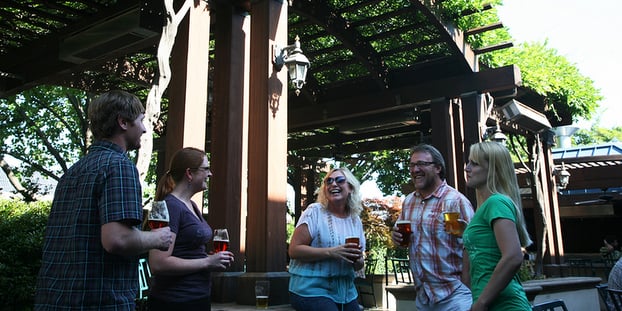
Right now, the plan is for the Sierra Nevada tasting room to offer capacity of around 40 to 50 people, with a focus on the main bar and additional communal tables that will allow tasting room staff to interact with the clientele and encourage craft beer conversation.
Brewery education was also a big factor in MIA Brewing’s brewery design. The tasting room is L-shaped and wraps around the brewhouse and primary fermentation area. The layout allows for a walking circuit tour that will take guests through all the brewing stages, from beginning to end. Along the wall there’s going to be a big open window so everyone can see the beautiful 20-bbl, three-vessel brewhouse system from Premier Stainless.
“As people are hanging out at a table, they can see the brewery at work,” Leon explained. “The tour is going to be an important part of the process. It’s also kind of required because in Florida, in order to have a tasting room, you have to be considered a tourist destination — education is going to be part of it. We want to educate people, whether it’s a resident or a tourist, about how we make craft beer.”
Najeway believes part of the Thirsty Dog’s tasting room uniqueness is that customers get a tour from a brewer, fresh off an eight-hour shift.
“You’re not going to get a tour from a tour guide here,” he said. “You get a tour from a brewer who has just finished eight hours brewing one of our beers. So, he’s looking forward to having a beer and talking about what he does. We practice that and pitch that to our events. We don’t have a sales team as much as we have people who work here that go to the events.”
Crafting choices
When you’re explaining the ins and outs of your brewing process and serving up pints of your latest creation, you’re sending a message that you’re focusing squarely on your own beer brand. The question becomes — how much exposure do you give to other breweries in your tasting room? Offering a featured guest brewer tap might be in your plans but Najeway said Thirsty Dog’s tasting room experience showed him that people come to his brewery for his beers.
“We don’t want this to feel like another bar in the area that’s taking away customers from other places. We want it to have a particular purpose — to educate folks on the different beers we make and the brewing process in general. I think a good way to do that is to make it a place where you’re encouraged to be up at the bar, interacting with our staff members, talking and learning about the beer …” — Ryan Arnold, communications manager for Sierra Nevada“Once in a while, I’ll have a keg from another brewery in the tasting room. I’ve even had up to four [guest brewery] kegs on tap in the tasting room. That’s not what people are coming here for,” he said. “They want to taste our beer. The guest beers didn’t sell. They work well when there’s one of them, but it digs into what people are coming for.”
Demand for Thirsty Dog beer at the tasting room has increased so much that Najeway is adding six more taps — with 12 taps already pouring. This will allow the brewery to always have a bourbon-barrel aged and sour beer on tap. Najeway will also run a line to the brewery’s own root beer.
Likewise, Sierra Nevada is putting a strong focus on its own beers at its planned tasting room.
“I think it’ll become pretty clear that’s going to be our focus at the tasting room,” Arnold said. “That’s not to say that we aren’t going to be supportive of the other venues and breweries in the area because that’s certainly an important part of it. We have good relationships with them, and we’re trying to create more with other businesses around us. It’s not that ‘We’re not pouring those guys because we’re not interested in them.’ In this instance, we’re going to focus on our products. If customers are looking for somewhere to go next, we’re happy to point them to another solid establishment that’s just down the street.”
A reoccurring tasting room theme is becoming part of the local community — brewing and beyond. If you’re opening a new brewery, part of that is building a bond with other local brewers you’ll be competing against. MIA Brewing, for example, plans to prominently feature its beers on its tasting room taps, but Leon is looking forward to featuring other Florida breweries and fostering a sense of Florida brewing pride.
“Having a brewery in Miami is an exciting challenge. It’s a big city, but there are no breweries up and running yet. We’ll be one of the first ones,” he said, proudly. “We’d like to have other local brewers on tap as well … We also want to further develop our own beer style in Florida. With the local ingredients — fruits and whatnot — and even culturally. There’s a different taste down here. We want to make beers that will succeed in our local communities.”
Outside of tap offerings, another decision brewers face is the tasting room environment — to entertain or not to entertain?
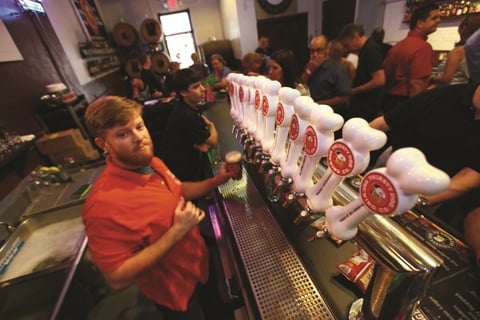
“There’s no TV. There’s no radio. The sole purpose of our bar is to come in, taste the beer, see how it’s made and decide what you want to drink here or take with you,” Najeway explained. “I remember telling that to some people, including my wife, and they said, ‘You really think people are going to come down there to drink beer?’ but it’s packed Thursday, Friday and Saturday. It’s jam packed every week. My numbers are up this year over last year, and last year was great.”
Craft beer tends to carry an air of sensibility and responsibility. It walks a fine line of alcohol beverage enjoyment and responsible, adult consumption. For Thirsty Dog and Sierra Nevada that means defining a different experience than a stereotypical bar where patrons are pounding 32-oz brews.
Leon isn’t concerned with making the tasting room / bar separation. His focus is on growing the craft community in Miami.
“Your objective is to have customers try your beers on a regular basis,” he said. “Let’s not fool ourselves; we don’t want them to have little sampling cups. We want them to be buying pints. While they’re there enjoying your beers, they’re going to spend a couple hours. It wouldn’t be a bad idea to have a pool table so they can relax or have a couple TVs so they could watch the Miami Heat play or something like that.”
At MIA Brewing, Leon is hoping to create a welcoming local hotspot that will offer Miami craft beer enthusiasts a place to hang out, shoot some pool and even see a live performance on the tasting room’s stage.
“On one side of the L-shaped bar, there’s going to be a pool table, dart boards and maybe some other games — more of a play area,” Leon explained. “I love playing pool, so I always wanted to include that. On the other side of the L, there’s going to be a room with a stage for local performers and live music, things like that.”
However you choose to design, build and run your tasting room, the best part is it often turns out to be a reflection of the brewery itself. The choices, atmosphere and craft offerings are just as unique as the different craft beers that brewery creates. Crafting a tasting room to showcase your unique, independent spirit is the foundation for creating lasting success.

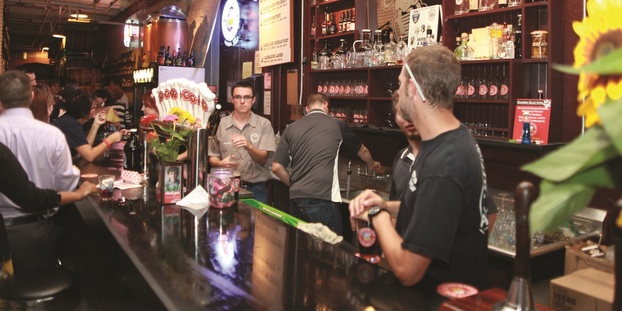

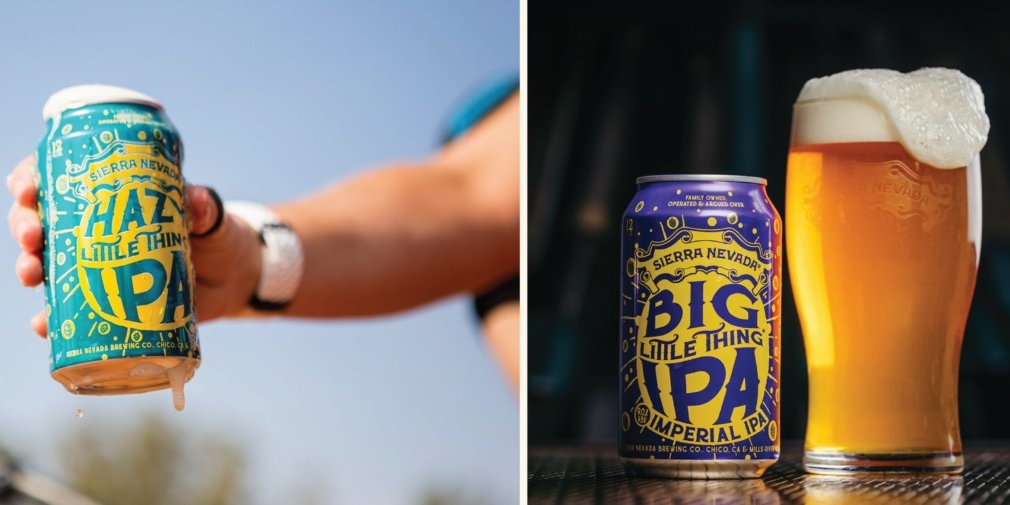
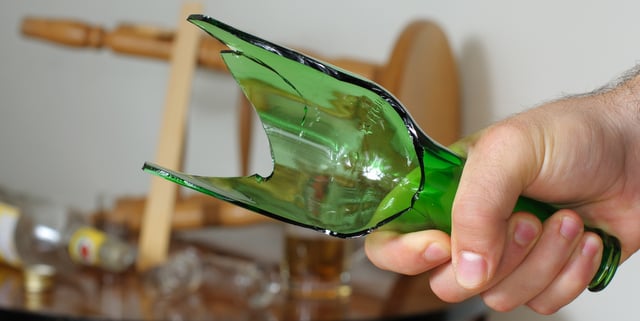
Tasting room tips: Build, run and brand your brewery showcase – Craft Brewing Business http://t.co/062yCS4Wgq
RT @PwRudy: “@CraftBrewingBiz: Tasting room takeaways: Build, run and brand your brewery showcase http://t.co/oNP269atFn“
“@CraftBrewingBiz: Tasting room takeaways: Build, run and brand your brewery showcase http://t.co/oNP269atFn“
@CraftBrewingBiz Thanks for including us in your #TastingRoom feature!
RT @CraftBrewingBiz: Tasting room takeaways: Build, run and brand your brewery showcase http://t.co/vpqiXeQP9s
A big thanks to @ThirstyDogBeer @SierraNevada @MIAbrewing for lending a voice to our #TastingRoom feature http://t.co/0grYl5P8x0